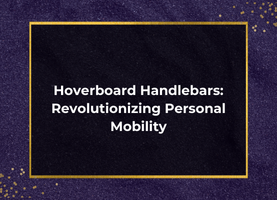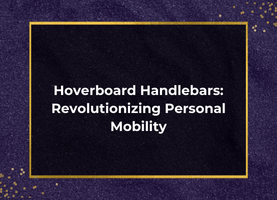
Hoverboard Handlebars: Revolutionizing Personal Mobility
Hoverboard Handlebars: Revolutionizing Personal Mobility
In an age where personal mobility devices are constantly evolving, the introduction of hoverboard handlebars has marked a significant milestone in the journey of hoverboard technology. These handlebars, along with various hoverboard attachments, have transformed the way we perceive and utilize hoverboards, turning them from a challenging mode of transportation into a more accessible and safer option for a broader demographic. As hoverboards continue to captivate the imagination of tech enthusiasts and everyday users alike, the addition of handlebars and hoverboard seat attachments has addressed some of the primary concerns related to balance and safety, making hoverboarding a more appealing and practical choice for personal mobility.
Hoverboard handlebars, alongside innovative hoverboard attachments such as the hoverboard go-kart attachment and hoverboard kart, not only enhance the functionality of hoverboards but also significantly improve the user experience by providing added stability and control. This innovative feature, coupled with the option of adding a hoverboard with seat or a hoverboard with seat attachment, has opened up hoverboarding to a wider audience, including those who may have been hesitant to try it due to safety concerns. With the global hoverboard market witnessing a steady growth, the focus on advancements such as handlebars and hoverboard attachments highlights the industry's commitment to making hoverboarding a safer and more enjoyable form of transportation and leisure activity.
As we delve into the world of hoverboard handlebars and hoverboard attachments, it becomes clear that these features are not just add-ons but fundamental shifts in hoverboard design that cater to the evolving demands of users. From offering enhanced safety to enabling better maneuverability, hoverboard handlebars and hoverboard attachments such as the hoverboard kart and hoverboard seat attachment are at the forefront of redefining personal mobility. This article explores the evolution, benefits, and practical aspects of hoverboard handlebars and attachments, shedding light on how they have become indispensable parts of the hoverboarding experience.
The Evolution of Hoverboard Handlebars and Attachments
The journey from the initial conception of hoverboards as a handlebar-less platform to the integration of handlebars and the addition of various hoverboard attachments represents a pivotal evolution in hoverboard technology. Initially celebrated for their futuristic appeal and minimalist design, hoverboards quickly revealed a gap in safety and accessibility that needed to be addressed.
The advent of hoverboard handlebars and hoverboard attachments like the hoverboard go-kart attachment was driven by a clear need for improved stability, user control, and versatility. Initially, users had to rely solely on their body weight and balance to steer and stabilize the hoverboard, a task that proved challenging for many. The introduction of handlebars and attachments such as the hoverboard kart and hoverboard seat attachments was a game-changer, providing a physical anchor that users could hold onto, which not only improved balance but also made steering more intuitive and precise.
This evolution was not instantaneous but the result of meticulous design enhancements and technological advancements. From fixed, rigid designs to the latest adjustable and detachable models, hoverboard handlebars and attachments such as the hoverboard with seat or hoverboard seat attachment have undergone significant transformations. These changes have made hoverboards more accessible to people of all ages and skill levels, promoting wider adoption and increasing their popularity as a mode of personal mobility.
The evolution of hoverboard handlebars and hoverboard attachments reflects the industry's responsiveness to user feedback and its commitment to safety and inclusivity. By addressing the initial limitations of hoverboards, handlebars and attachments like the hoverboard go-kart have played a crucial role in transitioning hoverboards from niche gadgets to mainstream mobility devices.
Types of Hoverboard Handlebars and Attachments
Hoverboard handlebars come in various designs, each catering to different preferences and requirements. Alongside handlebars, the hoverboard attachments market has expanded to include a variety of options that enhance the hoverboarding experience. Understanding the types of handlebars and attachments available is crucial for users to make an informed decision that best suits their needs.
| Type | Description | Ideal For |
|---|---|---|
| Fixed Handlebars | Permanently attached to the hoverboard, offering robust stability and support. | Beginners or those prioritizing safety, as they provide a constant, sturdy grip. |
| Adjustable Handlebars | Can be modified to suit different heights and preferences, offering versatility and comfort. | Families or shared hoverboards, ensuring a comfortable ride for everyone. |
| Removable Handlebars | Can be detached for easy storage and transport, providing ultimate flexibility and convenience. | Commuters and those valuing portability for a compact form when not in use. |
| Hoverboard Attachments | Includes options like hoverboard karts (transforming a hoverboard into a go-kart) and seat attachments for a relaxed, seated experience. | Enhancing versatility and fun, catering to diverse preferences and activities. |
The diversity in hoverboard handlebar types and hoverboard attachments underscores the importance of personalization in modern mobility devices. Whether it's fixed for stability, adjustable for comfort, removable for convenience, or enhanced through attachments like the hoverboard with seat or hoverboard kart, each option offers unique benefits to enhance the hoverboarding experience.
Benefits of Hoverboard Handlebars and Attachments
The integration of handlebars into hoverboards, along with the addition of various hoverboard attachments, has brought about a host of benefits, significantly impacting the overall user experience. These advantages go beyond mere physical support, contributing to the safety, control, accessibility, and enjoyment of hoverboarding.
Enhanced Safety: The primary benefit of hoverboard handlebars and attachments such as the hoverboard seat attachment is the increased safety they provide. By offering something to hold onto or sit on, riders are less likely to fall, reducing the risk of injuries. This safety feature is especially important for beginners and younger riders, making hoverboarding a more family-friendly activity.
Improved Control and Maneuverability: With handlebars, riders gain better control over their hoverboard, allowing for more precise movements and easier steering. The addition of attachments like the hoverboard kart further enhances maneuverability, making it possible to navigate crowded spaces and perform turns with greater confidence.
Accessibility for All Skill Levels: Handlebars and attachments like the hoverboard with seat lower the learning curve associated with hoverboarding, making it accessible to users of all skill levels. This inclusivity has expanded the hoverboard community, welcoming individuals who might have previously been intimidated by the balance requirements of traditional hoverboards.
Hoverboard handlebars and hoverboard attachments significantly enhance the user experience by providing safety, control, accessibility, and enjoyment. These benefits have not only made hoverboarding safer but also more enjoyable and inclusive, contributing to the growing popularity of this innovative mode of transportation.
Installation and Compatibility
Choosing the right hoverboard handlebars and ensuring their compatibility with your device is crucial for a seamless and safe hoverboarding experience. The process of installation, along with understanding the compatibility aspects, can greatly influence the performance and usability of the hoverboard, especially when incorporating hoverboard attachments like the hoverboard go-kart attachment or hoverboard kart.
Installation Process: The installation of hoverboard handlebars or hoverboard attachments such as the hoverboard seat attachment can vary depending on the type of handlebars or attachment and the specific hoverboard model. Some handlebars and attachments are designed for easy, tool-free attachment, making them user-friendly for those looking to convert their hoverboard into a hoverboard with seat or add a hoverboard kart. However, others may require specific tools and a bit of technical know-how. It's essential for users to follow the manufacturer's instructions closely to ensure a secure fit, thereby enhancing the safety and functionality of their hoverboard.
Compatibility Considerations: Not all handlebars or hoverboard attachments are universally compatible with every hoverboard model. Factors such as the size, shape, and design of the hoverboard can affect which handlebars or attachments, like the hoverboard seat attachment or hoverboard kart, can be attached to it. Before making a purchase, users must check compatibility to avoid issues with installation and use. This step is vital to ensure that the added components, whether for utility or enjoyment, do not compromise the hoverboard's performance.
Proper installation and ensuring compatibility are essential steps in integrating handlebars or hoverboard attachments with a hoverboard. These considerations guarantee that the handlebars or attachments, such as the hoverboard go-kart attachment, provide the intended benefits without compromising the safety or functionality of the hoverboard.
Maintenance and Care
Regular maintenance and care are vital for keeping your hoverboard handlebars and hoverboard attachments in optimal condition. These practices not only extend the lifespan of the handlebars and attachments but also ensure they continue to provide safety and support during use.
Routine Inspections: Regularly checking the handlebars and any hoverboard attachments for signs of wear and tear or loose components can prevent potential accidents. This includes tightening any screws that may have become loose over time and inspecting for any damage that might affect the structural integrity of the handlebars or attachments like the hoverboard seat attachment or hoverboard kart.
Cleaning and Upkeep: Keeping the handlebars and hoverboard attachments clean from dirt and grime is important for maintaining hygiene and ensuring smooth operation. A simple wipe down with a damp cloth can keep the handlebars and attachments looking and functioning their best.
Proper Storage: When not in use, storing the hoverboard and its handlebars and attachments in a cool, dry place away from direct sunlight can prevent damage and extend their usability. This is particularly important for removable handlebars and attachments, which may be more susceptible to environmental factors when detached.
Effective maintenance and care are crucial for the longevity and performance of hoverboard handlebars and hoverboard attachments. By adhering to a regular upkeep schedule, users can enjoy a safer, more reliable hoverboarding experience over time.
Hoverboard Handlebars: Enhancing Personal Mobility for the Future
The development and integration of hoverboard handlebars have significantly enhanced the appeal and safety of hoverboards as a mode of personal mobility. From their evolutionary beginnings to the diverse types available today, handlebars, along with hoverboard attachments such as the hoverboard go-kart attachment and hoverboard kart, have addressed many of the concerns associated with hoverboarding. These enhancements make hoverboarding a more accessible and enjoyable activity for users of all ages and skill levels. As hoverboards continue to evolve, the focus on safety, control, and accessibility provided by handlebars and attachments will undoubtedly remain a central theme in the quest to perfect personal mobility devices. By choosing the right type, ensuring proper installation and compatibility, and maintaining their condition, hoverboard users can maximize the benefits of their device, paving the way for a future where hoverboarding is not just a novelty but a practical and widespread means of transportation and fun.
FAQs
What is the name of the hoverboard with handle?
The hoverboard with a handle is often referred to as a "hoverboard scooter" or a "self-balancing scooter with a handlebar." One popular model is the Segway miniPRO or Ninebot S.
Are hoverboards safe for 13 year olds?
Hoverboards can be safe for 13-year-olds with proper supervision, safety gear (like helmets and knee pads), and if the hoverboard meets safety standards (UL certified). It's important to choose a model suitable for the child's age and weight.
What are hoverboards really called?
Hoverboards are officially known as "self-balancing scooters." These devices consist of two motorized wheels connected by a platform on which the rider stands, controlling the speed and direction by leaning.
Are hoverboards legal?
The legality of hoverboards varies by location. In some areas, they are legal to use on private property but not on public roads and sidewalks. It's important to check local laws and regulations regarding their use in public spaces.
Follow Us
Trending Articles
Newsletter
Aliqu justo et labore at eirmod justo sea erat diam dolor diam vero kasd



